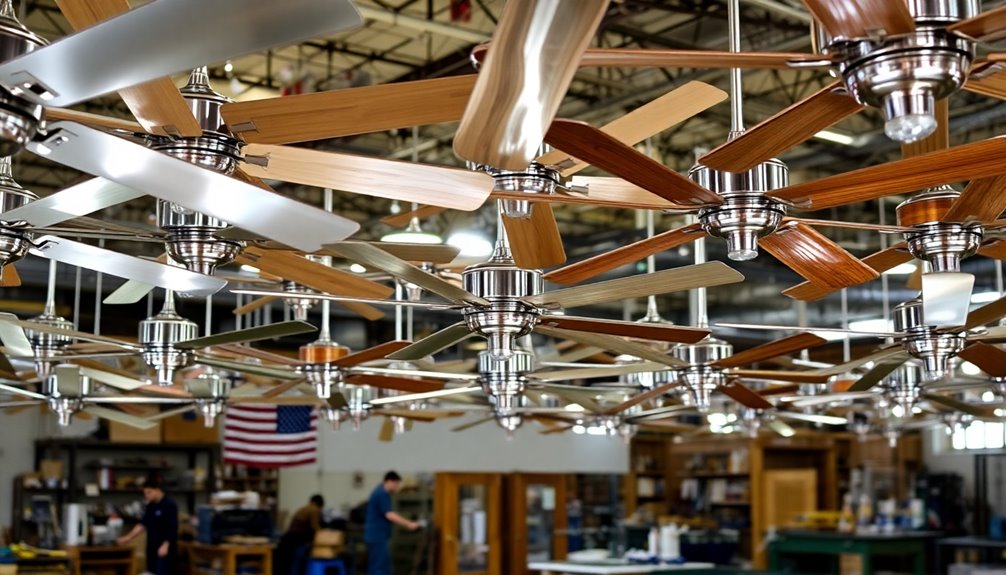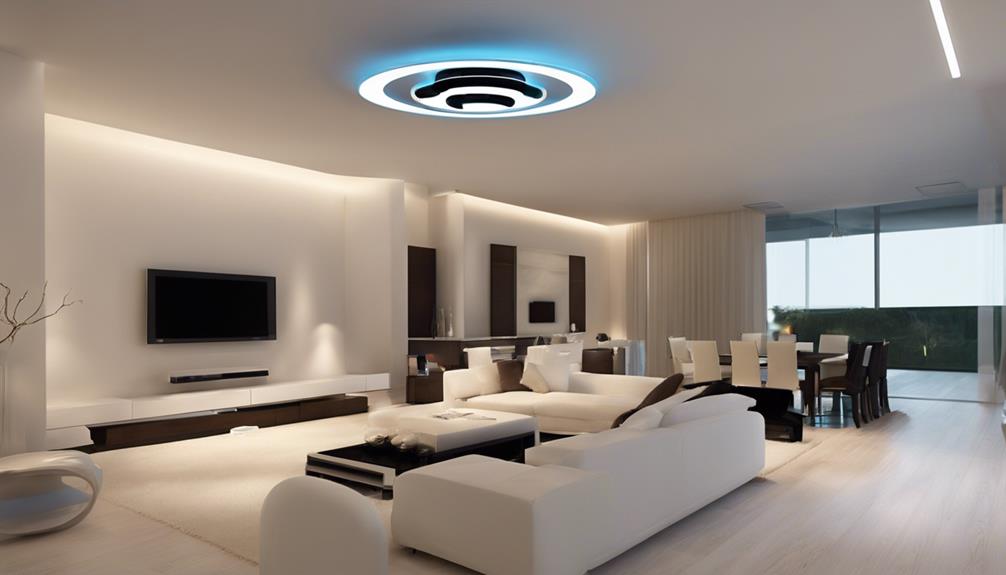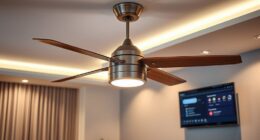Commercial ceiling fans are important for keeping spaces comfortable and managing energy costs. This guide will help you understand the differences between DC (Direct Current) and AC (Alternating Current) motors in commercial ceiling fans. We’ll look at how they work, compare their energy efficiency, and discuss long-term costs to help you make the best choice for your business.
Key Takeaways
| Feature | DC Motors | AC Motors |
|---|---|---|
| Energy Efficiency | Up to 70% more efficient | Standard efficiency |
| Speed Control | Up to 6 speed settings | Typically 3 speed settings |
| Noise Level | Quieter operation | Can be noisier at high speeds |
| Lifespan | Generally longer | Standard lifespan |
| Initial Cost | Higher | Lower |
| Smart Integration | More compatible with smart systems | Limited smart features |
Understanding DC Motors in Commercial Ceiling Fans
DC motors have made ceiling fans much better. These new motors have many advantages over old AC motors, making them a popular choice for businesses. Here’s why they’re so good:

1. Energy Efficiency: DC motors use up to 70% less power than AC motors. This means big savings on electricity bills, especially in large spaces with many fans running for a long time.
2. Better Speed Control: DC fans usually have up to 6 speed settings. This lets you control the airflow more precisely, making the room more comfortable while using less energy.
3. Quiet Operation: DC motors are quieter because of how they’re built. This is great for places like offices or classrooms where noise can be a problem. They also last longer and need less maintenance.
4. Long Life: DC motors have fewer moving parts and don’t get as hot when running. This means they usually last longer than AC motors, so you don’t have to replace them as often.
The Traditional AC Motor: A Comparison
AC motors have been used in ceiling fans for a long time, but they have some drawbacks compared to DC motors:
1. Energy Use: AC motors use more electricity, which can lead to higher bills over time. This is especially true in businesses where fans run all day.
2. Speed Options: Most AC fans only have 3 speeds (low, medium, high). This makes it harder to get the perfect balance of comfort and energy saving.
3. Noise: AC motors can make a humming sound, especially at high speeds. This can be annoying in quiet places like libraries or meeting rooms.
4. Maintenance: AC motors have parts called capacitors that wear out and need to be replaced. This means more maintenance costs over time.
Energy Efficiency Breakdown: DC vs AC Motors
Let’s look closer at how DC and AC motors in commercial ceiling fans compare in energy efficiency:
Ceiling Fan Motor Energy Consumption
As you can see in the chart, DC motors use much less energy than AC motors. This means big savings for businesses, especially in large spaces with many fans. DC motors are more efficient because:
1. They waste less power when changing electricity into movement.
2. You can adjust their speed more precisely, so you use only the energy you need.
3. They don’t get as hot, which means they use less energy and last longer.
4. Smart DC motors can automatically adjust to save even more energy.
Smart Integration: DC Motors and Building Management Systems
DC motor ceiling fans work well with modern building systems. These smart fans have cool features that can save more energy and make people more comfortable:
1. Wi-Fi Control: Many DC fans can be controlled with a smartphone app. This lets building managers adjust fans even when they’re not in the building, saving energy when no one’s around.
2. Motion Sensors: Some fans have sensors that turn them on or change speed when people are in the room. This saves energy by only running the fan when it’s needed.
3. Temperature and Humidity Control: Advanced DC fans can work with air conditioning systems to keep rooms comfortable while using less energy.
4. Building System Integration: DC fans can often connect to larger building management systems. This allows for better control of energy use across the whole building.
Performance Factors: Airflow and Noise Levels
DC motor ceiling fans perform better than AC fans in two important ways:
Airflow Efficiency: DC motors move air better, even at low speeds. This means you can cool a room using less energy. This is especially helpful in big, open spaces where you need good air circulation without running fans at high speed all the time.
Noise Reduction: DC motors are much quieter than AC motors. This is great for places like libraries, classrooms, or offices where noise can be distracting. Even when running fast, DC fans stay quiet, so you can have more air movement without making more noise.
Installation and Maintenance Considerations
When thinking about using DC motor ceiling fans in your business, keep these things in mind:
1. Starting Cost: DC fans usually cost more to buy than AC fans. But they often save money over time because they use less energy.
2. Installation: DC fans might need slightly different wiring than AC fans. It’s best to have an electrician who knows about DC fans install them.
3. Maintenance: DC motors usually need less maintenance than AC motors because they have fewer parts that can wear out. But when they do need repairs, it might be more specialized and cost more.
Environmental Impact: Beyond Energy Savings
Choosing DC motor ceiling fans for your business doesn’t just save energy. It’s also good for the environment:
Key Points: DC Motor Ceiling Fans
- Use up to 70% less energy than traditional AC motor fans
- Offer more precise speed control with up to 6 settings
- Run more quietly due to improved motor technology
- Have a longer lifespan with fewer moving parts
- Can integrate with smart home systems for added convenience
DC motor fans help reduce the amount of electricity your building uses. This means less pollution from power plants. They also last longer, so you don’t have to replace them as often, which means less waste. Some green building programs, like LEED, give points for using energy-efficient equipment like DC fans.
Cost Analysis: Initial Investment vs Long-Term Savings
When thinking about switching to DC motor ceiling fans, it’s important to look at both the starting cost and the long-term savings:
| Factor | DC Fans | AC Fans |
|---|---|---|
| Initial Cost | Higher | Lower |
| Energy Efficiency | High | Moderate |
| Lifespan | Longer | Shorter |
| Maintenance Cost | Key Differences: AC Motor: Operates on Alternating Current (AC). Has a stator and a rotor. Generally doesn’t use brushes or commutators. Types include induction motors and synchronous motors. DC Motor: Operates on Direct Current (DC). Includes brushes, a commutator, and a rotor.…— Taha N Alasemi (@tahaalasemi) December 2, 2025Lower | Higher |
| Long-term Savings | Significant | Moderate |
DC fans cost more to buy at first, but they can save you money over time. Here’s what to think about:
1. Energy Savings: Figure out how much you could save on electricity based on how much you use the fans and your electricity prices.
2. Maintenance Costs: DC fans usually need less maintenance, which can save money on repairs and replacements.
3. Lifespan: DC fans often last longer, so you don’t have to buy new ones as often.
4. Productivity Benefits: Better comfort and less noise might help people work better, which could be good for business.
5. Incentives: Check if there are any programs that give money back for installing energy-efficient equipment like DC fans.
Choosing the Right DC Ceiling Fan for Commercial Spaces
When picking DC ceiling fans for your business, think about these things:
1. Size: Choose fans that fit your room size. Bigger rooms might need fans with blades 52 inches or longer.
2. Airflow: Look for fans that move a lot of air efficiently. Check the CFM (Cubic Feet per Minute) rating. Airflow performance is significantly influenced by the fan blade pitch and airflow design. A steeper blade pitch often indicates the fan’s ability to move more air with less effort, improving overall efficiency. By taking blade pitch into account alongside the CFM rating, you can ensure you’re selecting a fan that delivers optimal circulation and comfort.
3. Smart Features: Consider fans with smart controls if you want to connect them to your building’s management system.
4. Lighting: Some DC fans come with LED lights, which can help save even more energy.
5. Warranty: Choose fans from good brands that offer solid warranties.
6. Look: Pick fans that match your building’s style.
7. Installation: Make sure the fans can be installed properly in your space.
8. Noise: Even though DC fans are usually quiet, check the noise ratings if you’re putting them in very quiet areas.
Conclusion: Making the Switch to DC Motors in Commercial Ceiling Fans
DC motor ceiling fans are a great choice for businesses looking to save energy and improve comfort. While they cost more upfront, they can save money over time through lower energy bills and less maintenance. They’re also quieter and can be controlled more precisely than traditional AC fans.
By thinking carefully about your needs and the points we’ve talked about, you can decide if DC fans are right for your business. They can help create a better working environment while also reducing costs and being better for the environment.
As technology gets better, we can expect DC fans to become even more efficient and useful. They’re already starting to work with smart building systems, which could lead to even more ways to save energy and improve comfort in the future.
Remember, choosing the right ceiling fan isn’t just about cooling – it’s an investment in your business’s efficiency, comfort, and environmental goals. DC motor fans can help you achieve these goals for years to come.
If you’re thinking about switching to DC fans, you might want to try them out in one area first. This can help you see how well they work in your specific situation before you install them everywhere.








